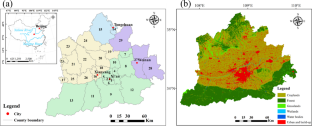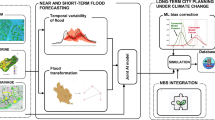Abstract
In the face of the persistent degradation of ecological environments and fragmentation of ecological networks brought about by rapid urbanization, this study focuses on examining the interaction between urban land use intensity and ecological networks in the Xi'an Metropolitan Region (XAMR), China, and their impact on ecological equilibrium and sustainable development. By comprehensively evaluating the changes in land use intensity in XAMR from 2010 to 2020, the aim is to underscore the pivotal role of ecological networks in maintaining urban ecological balance and promoting sustainable development. The findings indicate a transition in land use intensity in the XAMR from low to high concentration, reflecting an intensification in land resource utilization during urbanization. However, the establishment and management of ecological networks can significantly enhance urban ecological security and biodiversity. Notably, this research identified crucial ecological corridors and source areas, augmenting the connectivity of urban green infrastructure and providing vital support for urban biodiversity. Additionally, a significant finding of this study is the spatial spillover effects generated by socioeconomic factors such as the proportion of tertiary and secondary industries and per capita GDP through the ecological network, which have profound impacts on land use intensity in the surrounding areas. These insights offer a novel understanding of the complex interactions within urban ecosystems, emphasizing the importance of incorporating ecological network construction in urban planning. Overall, through a comprehensive analysis of the relationship between the ecological network and land use intensity in the XAMR, this study proposes new directions for urban ecosystem management and land use planning, highlighting the significance of scientific ecological network planning and management in achieving long-term sustainable development in urbanization processes.








Similar content being viewed by others
Data availability
Data will be made available on request.
References
Abass K, Adanu SK, Agyemang S (2018) Peri-urbanisation and loss of arable land in Kumasi Metropolis in three decades: evidence from remote sensing image analysis. Land Use Policy 72:470–479. https://doi.org/10.1016/j.landusepol.2018.01.013
BabíAlmenar J, Bolowich A, Elliot T, Geneletti D, Sonnemann G, Rugani B (2019) Assessing habitat loss, fragmentation and ecological connectivity in Luxembourg to support spatial planning. Landsc Urban Plan 189:335–351. https://doi.org/10.1016/j.landurbplan.2019.05.004
Bindajam AA, Mallick J, Hang HT (2023) Assessing landscape fragmentation due to urbanization in English Bazar Municipality, Malda, India, using landscape metrics. Environ Sci Pollut Res 30:68716–68731. https://doi.org/10.1007/s11356-023-27252-2
Cao X, Liu Y, Li T, Liao W (2019) Analysis of spatial pattern evolution and influencing factors of regional land use efficiency in China based on ESDA-GWR. Sci Rep 9:520. https://doi.org/10.1038/s41598-018-36368-2
Chu M, Lu J, Sun D (2022) Influence of urban agglomeration expansion on fragmentation of green space: a case study of Beijing-Tianjin-Hebei urban agglomeration. Land 11. https://doi.org/10.3390/land11020275
Ding M, Liu W, Xiao L, Zhong F, Lu N, Zhang J et al (2022) Construction and optimization strategy of ecological security pattern in a rapidly urbanizing region: a case study in central-south China. Ecol Indic 136. https://doi.org/10.1016/j.ecolind.2022.108604
Erb KH, Haberl H, Jepsen MR, Kuemmerle T, Lindner M, Muller D et al (2013) A conceptual framework for analysing and measuring land-use intensity. Curr Opin Environ Sustain 5:464–470. https://doi.org/10.1016/j.cosust.2013.07.010
Esau I, Miles VV, Davy R, Miles MW, Kurchatova A (2016) Trends in normalized difference vegetation index (NDVI) associated with urban development in northern West Siberia. Atmos Chem Phys 16:9563–9577. https://doi.org/10.5194/acp-16-9563-2016
Fan F, Wen X, Feng Z, Gao Y, Li W (2022a) Optimizing urban ecological space based on the scenario of ecological security patterns: the case of central Wuhan, China. Appl Geogr 138. https://doi.org/10.1016/j.apgeog.2021.102619
Fan X, Rong Y, Tian C, Ou S, Li J, Shi H et al (2022b) Construction of an ecological security pattern in an urban–lake symbiosis area: a case study of Hefei Metropolitan Area. Remote Sens 14. https://doi.org/10.3390/rs14102498
Gaaff A, Reinhard S (2012) Incorporating the value of ecological networks into cost–benefit analysis to improve spatially explicit land-use planning. Ecol Econ 73:66–74. https://doi.org/10.1016/j.ecolecon.2011.10.021
Gren Å, Andersson E (2018) Being efficient and green by rethinking the urban-rural divide—combining urban expansion and food production by integrating an ecosystem service perspective into urban planning. Sustain Cities Soc 40:75–82. https://doi.org/10.1016/j.scs.2018.02.031
Harvey E, Gounand I, Ward CL, Altermatt F, Cadotte M (2017) Bridging ecology and conservation: from ecological networks to ecosystem function. J Appl Ecol 54:371–379. https://doi.org/10.1111/1365-2664.12769
Hou W, Zhou W, Li J, Li C (2022) Simulation of the potential impact of urban expansion on regional ecological corridors: a case study of Taiyuan, China. Sustain Cities Soc 83. https://doi.org/10.1016/j.scs.2022.103933
Huang X, Wang H, Shan L, Xiao F (2021) Constructing and optimizing urban ecological network in the context of rapid urbanization for improving landscape connectivity. Ecol Indic 132. https://doi.org/10.1016/j.ecolind.2021.108319
Jia Q, Jiao L, Lian X, Wang W (2023) Linking supply-demand balance of ecosystem services to identify ecological security patterns in urban agglomerations. Sustain Cities Soc 92. https://doi.org/10.1016/j.scs.2023.104497
Jiang L, Deng X, Seto KC (2013) The impact of urban expansion on agricultural land use intensity in China. Land Use Policy 35:33–39. https://doi.org/10.1016/j.landusepol.2013.04.011
Kiziltan M (2021) Water-energy nexus of Turkey’s municipalities: evidence from spatial panel data analysis. Energy 226. https://doi.org/10.1016/j.energy.2021.120347
Li W, Wang D, Li H, Liu S (2017) Urbanization-induced site condition changes of peri-urban cultivated land in the black soil region of northeast China. Ecol Ind 80:215–223. https://doi.org/10.1016/j.ecolind.2017.05.038
Li W, Wang Y, Xie S, Cheng X (2021) Coupling coordination analysis and spatiotemporal heterogeneity between urbanization and ecosystem health in Chongqing municipality, China. Sci Total Environ 791:148311. https://doi.org/10.1016/j.scitotenv.2021.148311
Li Y, Liu W, Feng Q, Zhu M, Yang L, Zhang J et al (2023b) The role of land use change in affecting ecosystem services and the ecological security pattern of the Hexi Regions, Northwest China. Sci Total Environ 855:158940. https://doi.org/10.1016/j.scitotenv.2022.158940
Li C, Wu Y, Gao B, Zheng K, Wu Y, Wang M (2023a) Construction of ecological security pattern of national ecological barriers for ecosystem health maintenance. Ecol Indic 146. https://doi.org/10.1016/j.ecolind.2022.109801
Liang J, Bai Y, Gao Z, Yang X, Li L, Zhang C et al (2022) A study on the dynamic relationship between landscape information and heat island intensity of urban growth patterns—a case of five cities in the Beijing–Tianjin–Hebei City Cluster. Sustainability 14. https://doi.org/10.3390/su142114099
Liu Y, Li Q, Yang L, Mu K, Zhang M, Liu J (2020) Urban heat island effects of various urban morphologies under regional climate conditions. Sci Total Environ 743:140589. https://doi.org/10.1016/j.scitotenv.2020.140589
Luo H, Li L, Lei Y, Wu S, Yan D, Fu X et al (2021) Decoupling analysis between economic growth and resources environment in Central Plains Urban Agglomeration. Sci Total Environ 752:142284. https://doi.org/10.1016/j.scitotenv.2020.142284
Ma P-F, Wu D-F, Lin T, Wu Z-J, Li Z-C, Liang Y-X et al (2022) Spatio-temporal coupling relationship between rural population and cultivated land changes at the county level in Guangdong Province. Sustainability 14. https://doi.org/10.3390/su142214929
Ma S, Ai B, Jiang H, Cai Y, Xie D (2023) Exploring the growth pattern of urban agglomeration in the terminal urbanization stage by integrating inertial driving factors, spatial development strategy, and urbanization cycle. Ecol Indic 149. https://doi.org/10.1016/j.ecolind.2023.110178
McGrath L (2023) Fostering ecological understanding in and engagement with local communities. Front Ecol Environ 21:403–403. https://doi.org/10.1002/fee.2681
Opdam P, Steingröver E, Sv Rooij (2006) Ecological networks: a spatial concept for multi-actor planning of sustainable landscapes. Landsc Urban Plann 75:322–332. https://doi.org/10.1016/j.landurbplan.2005.02.015
Qian M, Huang Y, Cao Y, Wu J, Xiong Y (2023) Ecological network construction and optimization in Guangzhou from the perspective of biodiversity conservation. J Environ Manag 336:117692. https://doi.org/10.1016/j.jenvman.2023.117692
Qiao Q, Zhen Z, Liu L, Luo P (2023) The construction of ecological security pattern under rapid urbanization in the Loess Plateau: a case study of Taiyuan City. Remote Sens 15. https://doi.org/10.3390/rs15061523
Ruan L, He T, Xiao W, Chen W, Lu D, Liu S (2022) Measuring the coupling of built-up land intensity and use efficiency: an example of the Yangtze River Delta urban agglomeration. Sustain Cities Soc 87. https://doi.org/10.1016/j.scs.2022.104224
Smidt SJ, Tayyebi A, Kendall AD, Pijanowski BC, Hyndman DW (2018) Agricultural implications of providing soil-based constraints on urban expansion: land use forecasts to 2050. J Environ Manag 217:677–689. https://doi.org/10.1016/j.jenvman.2018.03.042
Song S, Wang S, Shi M, Hu S, Xu D (2022) Urban blue-green space landscape ecological health assessment based on the integration of pattern, process, function and sustainability. Sci Rep 12:7707. https://doi.org/10.1038/s41598-022-11960-9
Tian Y, Sun C (2018) A spatial differentiation study on comprehensive carrying capacity of the urban agglomeration in the Yangtze River Economic Belt. Reg Sci Urban Econ 68:11–22. https://doi.org/10.1016/j.regsciurbeco.2017.10.014
Wang Y-C, Shen J-K, Xiang W-N (2018) Ecosystem service of green infrastructure for adaptation to urban growth: function and configuration. Ecosyst Health Sustain 4:132–143. https://doi.org/10.1080/20964129.2018.1474721
Wang X, Dietrich JP, Lotze-Campen H, Biewald A, Stevanović M, Bodirsky BL et al (2020) Beyond land-use intensity: assessing future global crop productivity growth under different socioeconomic pathways. Technol Forecast Soc Chang 160. https://doi.org/10.1016/j.techfore.2020.120208
Wu L, Fan F (2022) Assessment of ecosystem services in new perspective: a comprehensive ecosystem service index (CESI) as a proxy to integrate multiple ecosystem services. Ecol Indi 138. https://doi.org/10.1016/j.ecolind.2022.108800
Wu B, Bao Y, Wang Z, Chen X, Wei W (2023) Multi-temporal evaluation and optimization of ecological network in multi-mountainous city. Ecol Indic 146. https://doi.org/10.1016/j.ecolind.2022.109794
Xu Y, Li P, Pan J, Zhang Y, Dang X, Cao X et al (2022) Eco-environmental effects and spatial heterogeneity of “production-ecology-living” land use transformation: a case study for Ningxia, China. Sustainability 14. https://doi.org/10.3390/su14159659
Xu Z, Dong B, Wang C, Gao X, Xu H, Wei Z et al (2023) Construction of international important wetland white-headed crane ecological corridor in Chongming Dongtan, China. Ecol Indic 149. https://doi.org/10.1016/j.ecolind.2023.110156
Yang J, Zeng C, Cheng Y (2020) Spatial influence of ecological networks on land use intensity. Sci Total Environ 717:137151. https://doi.org/10.1016/j.scitotenv.2020.137151
Zeng C, Yang L, Dong J (2017a) Management of urban land expansion in China through intensity assessment: a big data perspective. J Clean Prod 153:637–647. https://doi.org/10.1016/j.jclepro.2016.11.090
Zeng C, Zhang A, Liu L, Liu Y (2017b) Administrative restructuring and land-use intensity—a spatial explicit perspective. Land Use Policy 67:190–199. https://doi.org/10.1016/j.landusepol.2017.05.034
Zhang W, Liu G, Yang Z (2020) Urban agglomeration ecological risk transfer model based on Bayesian and ecological network. Resour Conserv Recycl 161. https://doi.org/10.1016/j.resconrec.2020.105006
Zhang Y, Cao Y, Huang Y, Wu JJES, Research P (2023) Integrating ecosystem services and complex network theory to construct and optimize ecological security patterns: a case study of Guangdong-Hong Kong-Macao Greater Bay Area, China. Environ Sci Pollut Res 1–20. https://doi.org/10.1007/s11356-023-27495-z
Zhou G, Huan Y, Wang L, Lan Y, Liang T, Shi B et al (2023) Linking ecosystem services and circuit theory to identify priority conservation and restoration areas from an ecological network perspective. Sci Total Environ 873:162261. https://doi.org/10.1016/j.scitotenv.2023.162261
Funding
This work was supported by the National Natural Science Foundation of China (Nos. U214320057, U2040208, 42007070 and 42277359), Key Laboratory Project of Shaanxi Provincial Education Department grant number 20JS100, and Shaanxi Province Innovation Capability Support Plan in 2022 grant number 2022KJXX-86.
Author information
Authors and Affiliations
Contributions
Yaotao Xu: data analysis and article writing, manuscript revision. Peng Li: ideas contribution and providing valuable suggestions, manuscript revision. Jinjin Pan: providing valuable suggestions and comments for the manuscript. Nibing Gong: providing valuable suggestions and comments for the manuscript. Zixuan Yan: data collection and collation. Junfang Cui: data collection and collation. Binhua Zhao: guidance in cartography. All authors contributed critically to the drafts and gave final approval for publication.
Corresponding author
Ethics declarations
Ethics approval
Not applicable.
Consent to participate
Not applicable.
Consent to publish
Not applicable.
Competing interests
The authors declare no competing interests.
Additional information
Responsible Editor: Zhihong Xu
Publisher's Note
Springer Nature remains neutral with regard to jurisdictional claims in published maps and institutional affiliations.
Supplementary Information
Below is the link to the electronic supplementary material.
Rights and permissions
Springer Nature or its licensor (e.g. a society or other partner) holds exclusive rights to this article under a publishing agreement with the author(s) or other rightsholder(s); author self-archiving of the accepted manuscript version of this article is solely governed by the terms of such publishing agreement and applicable law.
About this article
Cite this article
Xu, Y., Li, P., Pan, J. et al. Spatial response of urban land use intensity to ecological networks: a case study of Xi'an Metropolitan Region, China. Environ Sci Pollut Res (2024). https://doi.org/10.1007/s11356-024-33562-w
Received:
Accepted:
Published:
DOI: https://doi.org/10.1007/s11356-024-33562-w




